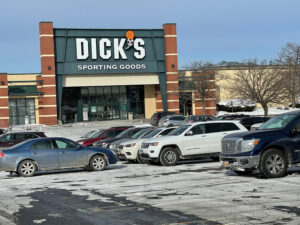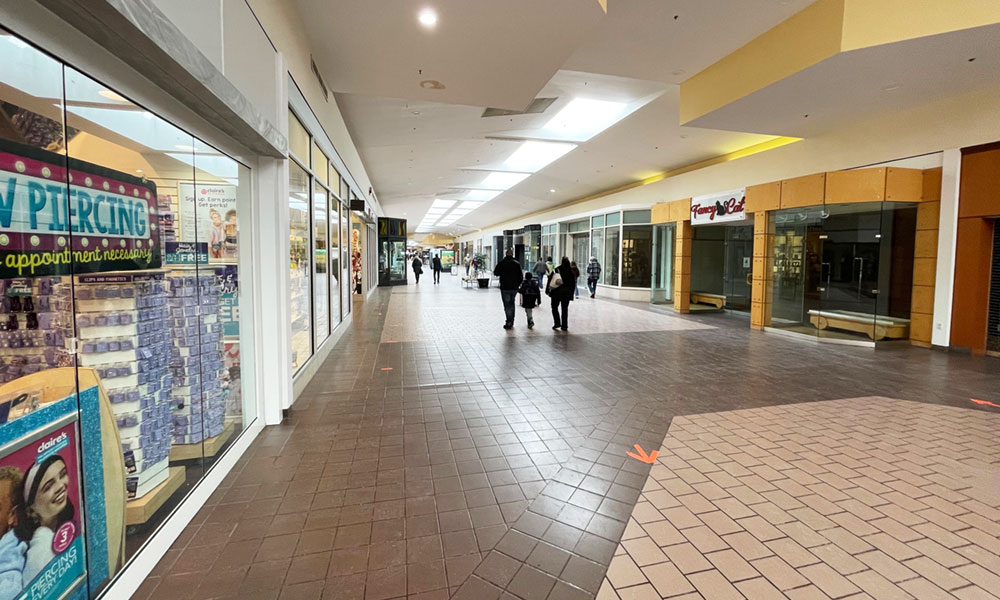Retail Council: Many factors exist as to why traditional malls are biting the dust
By Lou Sorendo

A once-treasured tradition is fading away.
Two suburban malls in Onondaga County — ShoppingTown in DeWitt and Great Northern in Clay are seemingly dying slow deaths.
According to a report by Credit Suisse, about 20% to 25% of all malls in the United States will close in the next five years. In 2017, more than 6,000 mall stores closed and left the malls.
Onondaga County is considering using ShoppingTown Mall as a site to vaccine people against COVID-19.
County officials reached an agreement with its owner, Moonbeam Capital, in November, and acquired the mall in December for $3.5 million. In January, the county issued a formal request for proposals to redevelop the mall.
ShoppingTown filed for protection from creditors under Chapter 11 of U.S. Bankruptcy Code in 2019 and never reopened after malls were ordered by Gov. Andrew Cuomo to close temporarily in March because of the coronavirus pandemic.
It has lost retail titans Macy’s, Dick’s Sporting Goods, J.C. Penney and Sears over the last several years.
Meanwhile, Great Northern Mall is struggling as well while losing nearly all of its retail tenants.
The mall is now losing its last anchor store — Dick’s Sporting Goods.
Dick’s, a longtime tenant of the mall, has notified the town of Clay it plans to move from the mall in the spring to the former Value City Furniture store next to Wegmans at 3965 Route 31.
Dick’s is Great Northern Mall’s last anchor store, so its departure is another nail in the coffin for the mall, which opened on Route 31 just east of Interstate 481 in 1988.
Competition from Syracuse’s Destiny USA, the largest mall in New York, has been a major challenge to Great Northern. Incidentally, Dick’s opened a large store in Destiny in 2012.
Competition from online retailers has led to the closing of all of Great Northern’s other anchor stores, including Sears and Macy’s, and most of its in-line stores.
The departures accelerated during the coronavirus pandemic and have left the mall with one national retailer, Old Navy.
All this follows a national trend that sees suburban malls losing their clout.
National trend
“There are plenty of factors. The overarching one is inherent restlessness of the shopper. What brought about shopping malls in the first place is that people wanted to see something new, and loved the idea of a new store,” said Ted Potrikus, former president and CEO of the Retail Council of New York State. He recently retired from the organization after working there for 31 years.
It was about 40 years ago when the mall ramp-up started.
“Real estate developers were buying up every parcel of land they could to put together these giant shopping malls,” he said. “One would be built and it was really popular. So they build another one, and that would be the one you couldn’t get near because it was popular, new and it was shiny.”
“Suddenly, the one that used to be new was sort of old,” he said. “And then another new one would arrive.”
Situated right between ShoppingTown and Great Northern on the I-81 corridor is Destiny USA, a six-story super regional shopping and entertainment complex that features 19 anchor tenants.
“That’s the shiniest of all,” Potrikus said.
“Suddenly, as these things get bigger, they tend to really suck the life out of the ones that started it all,” he said. “That’s no fault of the developers; that’s just the way we are as shoppers. We want to go to the place that’s new.”
Over the past 15 years or so, shopping on the internet has become the rage.
“If you are any kind of retailer, if you don’t keep updating your website and keep stuff new, you are going to lose your audience,” he said. “Shoppers are more restless now than ever before because they have more choices than ever before.”
The original intent of the shopping mall was to give shoppers many choices.
“To use an old tired phrase, people would ‘shop the day away.’ That’s what people liked to do, and they don’t like doing that anymore,” Potrikus added.
According to retail experts, an ongoing trend is that people like to spend money on experiences and not goods, because they can get items like their pants, shoes, iPods and all other things online, he said.
An ‘overbuilt’ industry
Simply put, Potrikus said one of the key issues is the retail sector — including malls — have been overbuilt.
“In the 90s, prior to the internet taking off as a shopping vehicle, it seemed like every parcel of open land ultimately became some sort of store or strip mall, and we are paying for that right now because they overbuilt,” he said.
“The question that I used to get is when all these stores were popping up was, ‘When is this going to stop? When are people going to stop building stores?’” he said.
“Suddenly, we had too many, and we were overstored. The competition was too steep. How many bookstores and drug stores can you have all selling the same things and all fighting for the same dollar?” he asked.
He said subsequently, businesses could not drop their prices anymore because margins were too thin.
He noted many companies that did build are now gone, such as The Wiz, Borders, and Circuit City.
“The graveyard is pretty full of these stores that for a while, you couldn’t get enough of,” he said. “But suddenly, you didn’t want to go in there anymore.”
He said many have been forgotten, such as Media Play and Caldor.
Potrikus said to not expect malls to be built in the ShoppingTown model, which is essentially “just a giant building with a whole bunch of stores.”
In terms of what’s popular and where the most shoppers have gone, it’s been to “power centers,” he noted.
“Power center I believe is a glitzier phrase for strip mall, where there is a discount store on one end and usually a home improvement store on the other end,” he noted. “In between, you have everything from a Chinese restaurant, hair salon, small grocery store and a liquor store. These are places where you can drive up to the door, go in and do your stuff, and drive out.”
Potrikus said strip malls like that will still be built, although that concept has even declined a bit over the years.
There are stores that remain extremely popular and attract customers by the droves, such as Target, Walmart and grocery stores such as Wegmans and Price Chopper.
Enhancing that popularity is an option where consumers can do their shopping online and then simply travel to the store to pick their items up.
Potrikus said this is how brick-and-mortar retail is competing.
“That is also why the classic indoor shopping mall model doesn’t necessarily work, unless one of those anchor stores has quick in and out where they can do that,” he said.
The shopping mall began with the suburbs. In 1956, the Southdale Center, America’s first indoor mall, opened in Edina, Minnesota, just outside of Minneapolis.
Life magazine called it “The Splashiest Center in the U.S.,” and praised its “goldfish pond, birds, art and 10 acres of stores all … under one Minnesota roof.” The indoor shopping craze soon spread to every corner of the United States. Three hundred malls opened by 1970, mainly catering to homemakers.
The trend continued and, by 2017, at its peak, America was home to over 1,200 malls, according to esquire.com.
Keep it fresh
While people still like to get out and shop, the question becomes where do they want to do it.
Potrikus said to expect a long gestation period as the pendulum swings back to the independent stores that are located more in an open-air environment, and that’s where shoppers can actually “touch and feel” merchandise.
Meanwhile, the traditional shopping malls are transitioning into something that is more of a nightclub and entertainment zone, he said.
“You won’t see as much of that ‘touch and feel’ stuff until Black Friday. A week before Black Friday every year, I am on the phone with reporters who are asking, ‘Why is it that people still like to go out?’ The answer is because they like to. I know that is hard to believe in 2019, but there still is a large part of the population that likes to get out and go to the mall.
“Where do they like to go? They like to go to the one that is shiny and up to date.”
Potrikus said there is a whole team of folks at Destiny USA whose sole purpose is to keep the mall new and different every day.
“That’s because Pyramid Management Group sunk a ton of money into it. That is not a short-term proposition that you’re looking at in the middle of the city. That is a long-term deal and they are gong to keep that place new so that the people of Central New York and beyond will see it as a destination point,” he added.
Potrikus said the successful malls today and those that will survive into the future feature a combination of shopping, entertainment and serve as a tourist attraction.
In essence, it’s not just about consuming goods, but also entertainment as well, he noted.
“Civic leaders — not just in New York but all over the country, are looking at ways to revitalize the downtowns that got eviscerated by the shopping mall,” he said. “However, now the pendulum has swung where people are eviscerating the shopping malls to get us back downtown.”
Pulling up anchors
The commercial-real-estate firm CoStar estimates that nearly a quarter of malls in the U.S., or roughly 310 of the nation’s 1,300 shopping malls, are at high risk of losing an anchor store.
Potrikus said many of them are simply reducing the number of brick-and-mortar locations they have.
He said a company takes a different approach when it takes losses in the stock market, watches annual sales decrease or fails to meet goals.
“Growth doesn’t necessarily mean, ‘I’m going to open X number of stores in the next fiscal year. Growth could mean, ‘I’m going to close a bunch of stores and take the money that we save there and put it back into the ones we keep so that the performance of those stores can grow. We want to invest into those rather than spread themselves too thin,’” Potrikus said.
Another factor in diminished brick-and-mortar locations is a changing leasing environment.
While the trend of building new stores in the retail sector skyrocketed in the ‘80s and ‘90s, owners were entering into traditional commercial leases of 20 or 30 years.
“So the leases that were taken out 20 to 30 years ago have come due,” causing many to balk at the idea of renewing a long-term pact, Potrikus said.
Many of the stores that disappeared in the mid-90s may also have signed enticing 50-year leases at the conclusion of World War II, and when it came time to renew, preferred not to because of a drastically changed marketplace.
Many could not sustain their margins at the new real estate rates.
“It just becomes too expensive of a business proposition to keep the store open,” he said.
“That could be one of the reasons why you see these anchor stores go. New paper is due, and the new paper doesn’t look anything at all like what it did in the past,” he said.
He noted that mall owners also have a tendency to think their property is worth more than it is, and the property ends up vacant for years because they are asking too much for that space.
Ripple effect
When anchor stores pull up stakes and leave, remaining stores suffer.
“It’s the anchor store that has the brand name on the outside of the mall, and it’s the anchor store that drives people to it,” he said.
“When an anchor store goes away and that sign comes down, people drive by,” he said. “For the stores that were closest to the anchor store, they lose foot traffic.”
“Whether you are a small or big retailer, a coffee shop or a restaurant, it’s that foot traffic that makes or breaks your day. So if the feet are not there, there’s no reason for you to be either,” he said.
From an economic development perspective, when a mall suffers, so does the community it is located in.
“What’s going to happen is the town is going to say, ‘Here is your tax bill.’ And the mall owner is going to say, “It’s not worth that much. I’m not bringing that much in with rent,’” he said.
Like in ShoppingTown’s case, the issue becomes a legal one.
“You also have activists who say these malls are a blight and eyesore,” he said.
Can malls like Great Northern make a comeback?
They should take a page out of Destiny’s book as Pyramid is adding on attractions such as nightclubs.
“It’s a mall but it isn’t a mall, but what it did was brought in more people. It’s that calculated, studied risk that will drive people to look at buildings like Great Northern Mall,” he said.
“The thing that will bring those malls back is if that is where everyone goes again,” he said. “With computers sitting there at home and in the palms of our hands, I think it’s going to be awfully hard.”
“So many of our shopping habits have been irrevocably changed by the Internet,” he said.
Potrikus said it comes down to two time-tested tenets of retail: “The shopper is always right and location, location, location,” he said. “Location now can be in your pajamas on your couch at 10:30 at night.”
“Right now, the shopping mall is not the location and it’s not where shoppers want to be for the day. If they go into a mall, it’s more to pinpoint a particular store. That’s why the stores with street-facing entrances are having a bit of a heyday now. You can park your car, walk in and out, and don’t have to walk past Orange Julius or wander the halls,” he said.
“The mall is gone. I think the ones that stay open are the ones that are figuring out how to reinvent themselves. It’s not easy,” he said.




